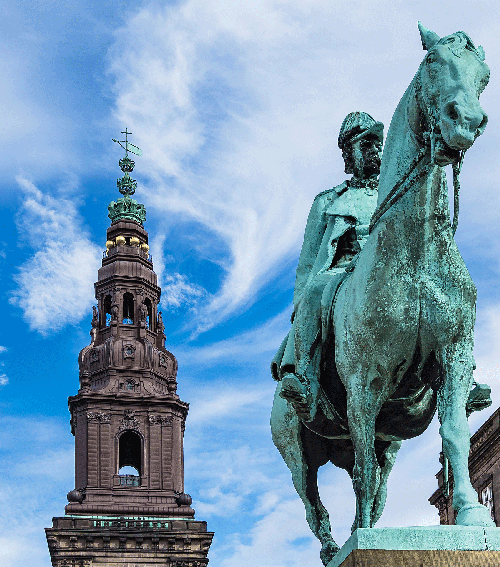The history of Denmark
The first humans in Denmark
The first Danes were hunters and fisherman who probably entered the country migrating from Southern and Eastern Europe by the end of the last Ice Age around 10,000 BC.
By 3000 BC, farms had begun to appear on the flat, fertile land we now call Denmark. At first, the farmers used stone tools and weapons, but they later adopted bronze and iron.
By the time of the Iron Age, the Danes had established trade links with the Roman Empire, trading goods such as animal furs and amber. By 200 AD, the Danish people had begun using the Rune language chiseled in stone.
The glamorous, violent Vikings
One of the most notorious periods in Danish history is the age of the Vikings. It began around 793 AD with the raids on the English tidal island of Lindisfarne. The Vikings were eventually to establish settlements in Yorkshire in Northern England and in Normandy in the Northwestern part of France.
The Viking Age lasted about 250 years. At one point, the Danish Viking Sweyn Forkbeard (Svend Tveskæg) and his son Canute the Great (Knud den Store) were the kings not only of Denmark but of Norway, Southern Sweden, Greenland, the Faroe Islands, Shetland, Orkney and parts of England.
The Vikings travelled widely outside their realm, sailing to what today is Russia and Turkey. Their admirable navigation skills at sea also brought them as far as Greenland and North America. They continued to plunder and steal, along with more peaceful activities such as trading precious metals, textiles, glassware, jewellery, and fur. On occasion, they also bought and sold European slaves.
Did you know
The introduction of Christianity
Following the baptism of the Danish King Harald Bluetooth in 965 AD, the Christian clergy became influential in Danish society. The newly-adopted religion, however, did not immediately turn the Danes into a peaceful people. They continued to fight to maintain and expand their territory, conquering parts of Germany and Estonia.
Nordic unity and rivalry
In 1397, with the Kalmar Union, Denmark (incl. Greenland and Iceland), Norway and Sweden was joined into a single monarchy ruled by the Queen Margrethe I.
The Kalmar Union lasted until Sweden broke away in 1523, the first shot in a long rivalry between Denmark and Sweden for dominance in the region. The two countries fought on a regular basis and in 1658 Denmark had to cede the provinces of Skåne, Halland and Blekinge, which today make up the Southernmost provinces of Sweden. In 1814, the sovereignty of Norway was transferred to Sweden too. Iceland gained independence in 1918.


Absolutism and democracy
Reforms in 1784 changed this scenario and paved the way for additional rights for the peasants, and in 1814 universal primary education was introduced.
This move led to the war with the Germans (1848-1851) which Denmark won. But tensions continued and Denmark was defeated by Germany in a renewed conflict in 1864. As a result, Denmark had to cede all three duchies.
The northern, predominantly Danish part of Schleswig, returned under Danish rule in 1920 as a result of a plebiscite following Germany’s defeat in World War I. Denmark remained neutral in World War I. A small German minority still lives in the region.
The German minority comprises approximately 10-15,000 people, who reside mainly in the southern and western parts of Sønderjylland, where they account for approximately 7 percent of the total population. Members of the German minority in Denmark are Danish nationals and speak both Danish and German. The German minority runs its own schools and day cares that receive funding from both the Danish and German governments.

Partnerships and prosperity
In 1972, Denmark joined the European Economic Community (EEC) - the leading economic partnership in Europe - which later became the European Union. Denmark was also one of the founding members of the United Nations (UN) and continues to be a member of the military alliance - the North Atlantic Treaty Organisation (NATO).
Important events in Danish history
C. 10000 BCE First hunters inhabit Danish lands
3900 BCE Basic society built on agriculture and animal husbandry
400 - 700 Urbanisation begins
866 - 867 Danish Vikings conquest York, which becomes the Viking capital of England
C. 965 Introduction of Christianity to Denmark
1015 - 1034 England under Danish rule
1397 - 1523 The Kalmar Union: Denmark, Norway, Sweden, Finland, Iceland, Greenland, the Faroe Islands, Shetland and Orkney
1479 Founding of the University of Copenhagen
1523 Loss of Sweden
1536 The Reformation, Norway incorporated into Denmark
1660 - 1661 Introduction of absolutism – absolute power of the monarchy
1666 - 1917 Danish colonies created in the Caribbean
1807 Copenhagen bombed by the English navy
1814 Loss of Norway
1848 Abolition of absolutism
1849 First democratic constitution - "the June Constitution"
1864 Loss of the duchies Schleswig, Holstein and Lauenburg
1914 - 1918 Danish neutrality during World War I
1915 Constitutional reform, enfranchisement of women
1918 Iceland gains independence from the Kingdom of Denmark
1920 North-Schleswig votes in favour of reunion with Denmark
1940 - 1945 German occupation during World War II
1945 Founding membership of the UN
1949 Membership of NATO
1973 Membership of the EEC
1993 Membership of the EU
2011 First female Prime Minister in office, Helle Thorning-Schmidt


